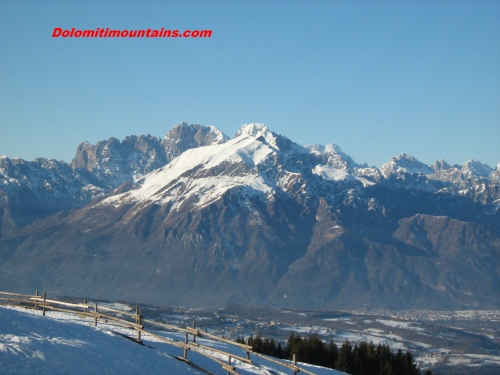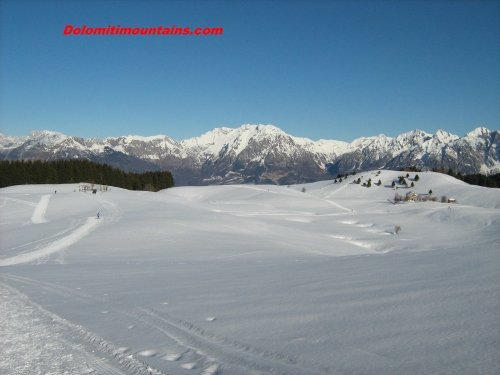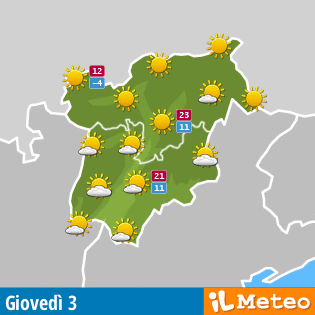Belluno Dolomites
Pale di S. Martino, S. Lucano and Vette Feltrine
 |
| Italian |

Belluno Dolomites are exactly part of a large group of mountains called the Pale di San Martino San Lucano Vette Feltre Belluno Dolomites lies in between the province of Trento and Belluno. Spread far 31.665 hectares and someone recall the shape of a horseshoe, into that area is folded Agordino. One of the main reasons because these mountains have become a world heritage site due to the fact that they are considered one of the most comprehensive set of layers of rock in the Dolomites that goes from the first Paleozoic to Cretaceous.
Pale di San Martino are on the western side overlooking the valleys of Primiero and Vanoi in Trento province, across from the valleys of Belluno Mountains: Biois and Cordevole. One of the highest peaks of this group is certainly the Cimon della Pala, 3.184 meters high and towers above the famous Passo Rolle and was joined for the first time by the Englishman Edward Robson Whitwell in 1870. Other major peaks are: the Velo della Madonna, the Sass Maor, the Cima Canali, the Mulaz, the top of the Cima Rosetta and the Cima della Mezzana. At the feet of the pale San Martino di Castrozza rises, popular tourist destination for summer and winter. These mountains are characterized by the presence of several glaciers, although small, because they are at a considerable altitude. The largest of these is north of the summit Fradusta and takes its name, this is a glacier of about one square kilometer of extension.
Many famous mountains are included in Belluno Dolomites area
The Pale di San Lucano appear as a continuation of the Pale di San Martino. They are gigantic cliffs that plunge to the valley 1500 meters for digging wanderful and deep canions . The San Lucano Valley is one of the deepest canion in the Alps. In the most northern of these large groups there is the Monte Civetta, 3.220 meters high. It is one of the most colossal blocks of rock of the Dolomites. The northern wall reaches a length of seven kilometers from the Coldai Tower going to the Trieste Tower. The central part instead reaches 1.100 meters in height. On these walls, many climbers have ventured climbing in the Dolomites, this great wall is always called "the University of climbing" or "Wall of Walls" for his boldness and monumental extension. Other major peaks, with sheer walls and also in yellow, are the First Pala of 2221 meters, the Second Pala of 2340 meters and the Third, which reaches 2355 meters.
The Belluno Dolomites and Feltre Peaks represent the southernmost part of the horseshoe. Those looking to the Piave Valley and the town of Belluno Dolomiti Area. These peaks are not very high as the others, but from the standpoint of wilderness are more difficult and inaccessible.
 |
 |
The Monti del Sole (Mountains of the Sun) are Moved to Feltre and belonging to the National Park of the Belluno Dolomites are developing a series of peaks in a semicircle around Val Soffia and also include the Group of Feruc. The area is considered one of the wildest, together with Friuli Dolomites, of all UNESCO sites in the Dolomites. East of this area there are two chains: Cimonega and Piani Eterni. In this area there is also a nature reserve known as the Piazza del Diavolo (Devil’s Squere) or, in ladin, Busa del Diaol. Towards the valley of Cordevole there is another group of peaks, Schiara-Talvena and northern the chain of Cime di San Sebastiano (S.Sebastiano Peaks). The most famous of Feltrine peaks are Mount Vallazza, 2.167 meters, the Pietena, 2.195 meters, the Cima Dodici (Top Twelve), 2.265 meters, Mount Pavione, 2.335 meters, Mount Ramezza, 2.250 meters, Sasso di Scarnia, 2.226.
These Feltrine peaks are formed mostly by gray limestone. They are also the area where lies the most complex geology of this UNESCO site, very interestin for the Geology of Dolomites. A large variety and lots of fossils are found among these rocks, including fossils of calcareous and siliceous sponges, and rare ammonites perfectly preserved. There is therefore no coincidence that this area is protected, and comes as a natural park that is in the Belluno Dolomites Natural Park, Pale di San Martino in the province of Trento.
